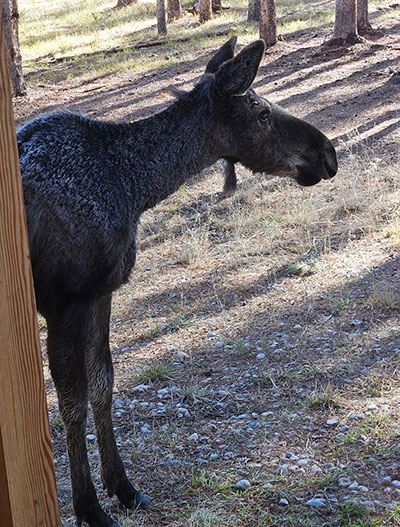Volunteers Spot Eight Moose During UW Biodiversity Institute’s Summer Moose Day Weekend
Published July 30, 2025

This young moose was spotted at a private residence near some of the Summer Moose Day routes but was not actually taken during Summer Moose Day weekend. This year’s Summer Moose Day weekend, held July 19-20, resulted in the spotting of six adult moose and two calves in the Pole Mountain area and in the Snowy Range. The UW Biodiversity Institute sponsored the event. (James Rinehart Photo)
For the ninth year, community scientists helped identify moose populations in the mountains outside of Laramie for Summer Moose Day weekend.
The eight moose seen this year were far more than the two witnessed in 2024.
“This Summer Moose Day, community scientists surveyed eight routes,” says Mason Lee, senior project coordinator for the University of Wyoming’s Biodiversity Institute. “Despite the low spatial coverage, community scientists reported moose observations from 25 percent of the surveyed routes.”
Twenty-six volunteers in 15 groups ventured out in Albany County July 19-20, covering three routes in the Pole Mountain area and five routes in the Snowy Range. The Biodiversity Institute sponsored the event.
The community scientists hiked or drove designated routes between dawn and midmorning. They recorded observations of moose or their signs, which include tracks/hoofprints, bed areas, scat droppings and browse on aspen and willows.
Of the eight moose surveyors saw, two were males, three were females, two were calves and one moose was of an unknown sex, Lee says.
“Many mule deer were spotted, as were a marmot and a mountain snail,” Lee adds.
The record of 16 moose spotted on Summer Moose Day was set in 2016 and matched again in 2022.
Postings from the current season can be found at https://www.inaturalist.org/projects/wyoming-virtual-bioblitz-2025. iNaturalist is a joint initiative of the California Academy of Sciences and the National Geographic Society.
The data gathered from Summer Moose Day are shared with biologists at UW. These biologists use the data collected by community scientists to further their understanding of the population densities of local moose, their reproductive rates, summer habitat quality, their winter ranges and how these variables change over time.
More will be learned after Dave Christianson, an associate professor in the UW Department of Ecosystem Science and Management, and his graduate students analyze the Summer Moose Day data as well as external factors that can affect moose counts, Lee says.
Both summer and winter Moose Day events are geared toward increasing the public’s understanding of moose in the Laramie area and involving the public in asking and answering questions. These events are an extension of the original program, Moose Day, held by Nature Mapping Jackson Hole (NMJH) in Jackson each winter. NMJH is a citizen science program created by the Jackson Hole Wildlife Foundation.
About the University of Wyoming Biodiversity Institute
The UW Biodiversity Institute fosters conservation of biodiversity through scientific discovery, creative dissemination, education and public engagement. In this setting, scientists, citizens, students and educators come together to share a wealth of perspectives on the study and appreciation of biodiversity -- from microbes to poetry and ecosystems to economics. Learn more at www.wyomingbiodiversity.org.

